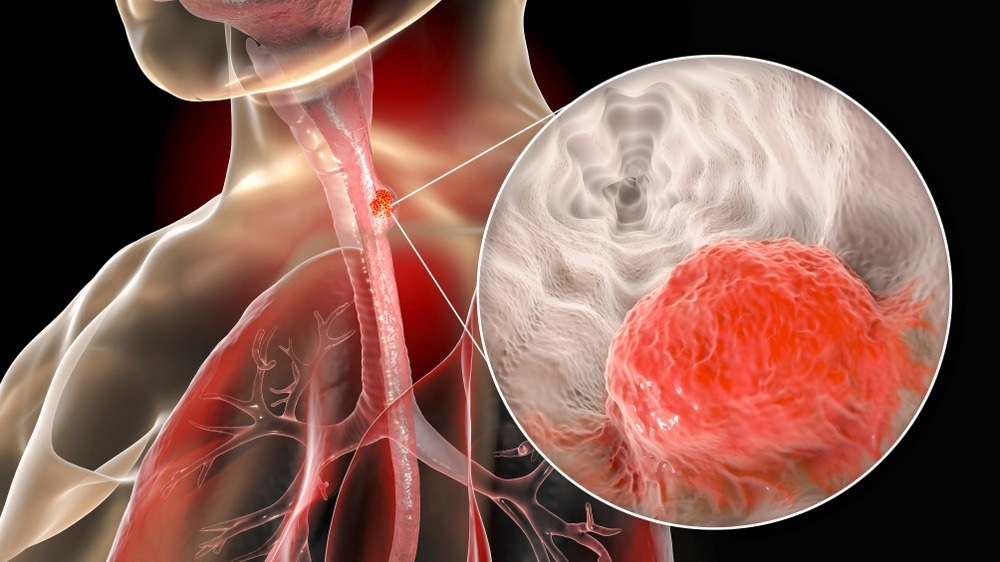Among the total number of deaths caused by different types of cancer, esophageal cancer is the sixth most significant. Several conventional treatments, such as radiotherapy, chemotherapy, and surgery have multiple side effects, including off-target toxicity and multidrug resistance (MDR).

Study: Targeted chemo-photodynamic therapy toward esophageal cancer by GSH-sensitive theranostic nanoplatform. Image Credit: Kateryna Kon/Shutterstock.com
Another strategy for esophageal cancer treatment is chemo-photodynamic therapy, the efficacy of which is limited by its inability to target tumors, lack of suitable microenvironment for photodynamic therapy (PDT), and tendency to cause adverse side effects.
Scientists sought to address these limitations of the existing therapies and developed a novel theranostic nanoplatform, namely, GCDs-Ce6/Pt-EGF, which has been found to be effective against esophageal cancer. This study has been recently published in Biomedicine & Pharmacotherapy.
Conventional Treatments of Esophageal Cancer
The majority of the available treatments for esophageal cancers come with some limitations. For instance, as this type of cancer is prone to metastasis, surgery cannot completely remove the tumor. In the case of radiotherapy, the narrow dose window limits its purpose. Low-dose radionuclides have limited tumor cell killing ability, while high dosage can affect healthy cells as well.
Although chemotherapy, using Cisplatin or Doxorubicin, can effectively eliminate tumor cells with metastasis and has a superior anti-tumor effect, it often severely damages the kidney and liver of the patient. Combinational therapy, such as chemoradiation with surgery, was effective against esophageal cancer, but this therapy showed high in-hospital mortality.
Two of the limitations associated with photothermal therapy and oxidative therapy are the recurrence of tumor cells and damage caused to off-target non-cancerous cells as well. PDT is effective against different types of cancers, such as breast, prostate, liver, and esophagus, with a better biosafety effect. However, its effectiveness is compromised by abundant glutathione (GSH) in the tumor microenvironment and hypoxia.
Nanotechnology-based Cancer Treatments
Nanoparticles are widely used in biomedical research, owing to their nanoscale dimension (1–100 nm) and multiple unique properties. Carbon nanodots are a type of carbon nanoparticle that is applied for fluorescence sensing, bioimaging, and drug delivery. The development of tumor-targeted drug delivery systems is essential to facilitate tumor-specific treatment without adversely affecting the normal cells.
Drugs are often modified to identify tumor cells by recognizing specific receptors expressed in them. In many types of cancers, including esophageal cancer, the epidermal growth factor receptor (EGFR) is found to be overexpressed. Compared to healthy individuals, esophageal cancer patients exhibit a significantly higher expression of EGFR protein in the mucosa. Hence, this receptor has been utilized as a key target for anti-tumor drug delivery.
A Novel Theranostic Nanoplatform for Esophageal Cancer Treatment
Recently, scientists have developed an all-in-one theranostic nanoplatform, known as GCDs-Ce6/Pt-EGF for esophageal cancer treatment. This nanoplatform utilized green fluorescence carbon dots (GCDs), which were synthesized using p-aminosalicylic acid and p-aminobenzamide with a molar ratio of 1:1 at 200℃ for 6 hours, via the hydrothermal method.
GCDs were characterized using atomic force microscopy (AFM) and transmission electron microscopy (TEM), which revealed a uniform dispersion of quasi-sphere GCD nanomaterials of 4.72 nm size. The fluorescence quantum yield of GCDs was estimated to be 10.62%. Most importantly, this nanoparticle exhibited excellent optical stability.
To construct the GCDs-Ce6/Pt-EGF nanoplatform, researchers grafted chlorin e6 (Ce6), which is a photosensitizer, chemotherapy agent Pt (IV), and the targeting unit epidermal growth factor (EGF) on GCDs. Here, the drug loading rates of Ce6 and Pt (IV) were estimated to be 8.53% and 19.36%, respectively. The drug loading capacity of GCDs-Ce6/Pt-EGF nanoplatform was observed to be significantly more than other nanoplatforms.
Post irradiation at 660 nm wavelength, photosensitizer Ce6 induced cell death by generating reactive oxygen species (ROS). This phenomenon induced tumor cell apoptosis. Both in vitro and in vivo studies strongly indicated that the GCDs-Ce6/Pt-EGF exhibited superior photodynamic properties and could be effectively applied for esophageal tumor imaging as well as the elimination of esophageal cancer cells (therapeutic effect).
The mechanism driving the GCDs-Ce6/Pt-EGF nanoplatform is the targeting of esophageal cancer cells, bearing EGFR, and penetration of the tumor cells. After internalization within the tumor cells, Pt(IV) gets converted to Pt(II) by intracellular GSH, which ultimately kills tumor cells.
Interestingly, this study revealed that GCDs-Ce6/Pt-EGF displayed better anti-tumor effects compared to Cisplatin. Researchers stated that this nanomedicine could not only restrict tumor cell migration but also target tumor cells by recognizing EGF receptors. Other important aspects of this theranostic nanoplatform are direct cell killing capacity by Pt(II) and laser irradiation.
The GCDs-Ce6/Pt-EGF nanoplatform displayed excellent biosafety, as it rendered negligible cytotoxicity to normal esophageal cells. This could be due to three reasons, i.e., superior tumor targeting capability that reduces off-target toxicity, the release of toxic platinum only in GSH-rich tumor microenvironment, and Ce6 induced PDT effect with laser irradiation. Scientists are optimistic that utilizing all-in-one GCDs-Ce6/Pt-EGF theranostic nanoplatform could be beneficial for treating esophageal cancer patients.
Reference
Ren, G. et al. (2022) Targeted chemo-photodynamic therapy toward esophageal cancer by GSH-sensitive theranostic nanoplatform. Biomedicine & Pharmacotherapy, 153. https://www.sciencedirect.com/science/article/pii/S0753332222008952?via%3Dihub
Disclaimer: The views expressed here are those of the author expressed in their private capacity and do not necessarily represent the views of AZoM.com Limited T/A AZoNetwork the owner and operator of this website. This disclaimer forms part of the Terms and conditions of use of this website.